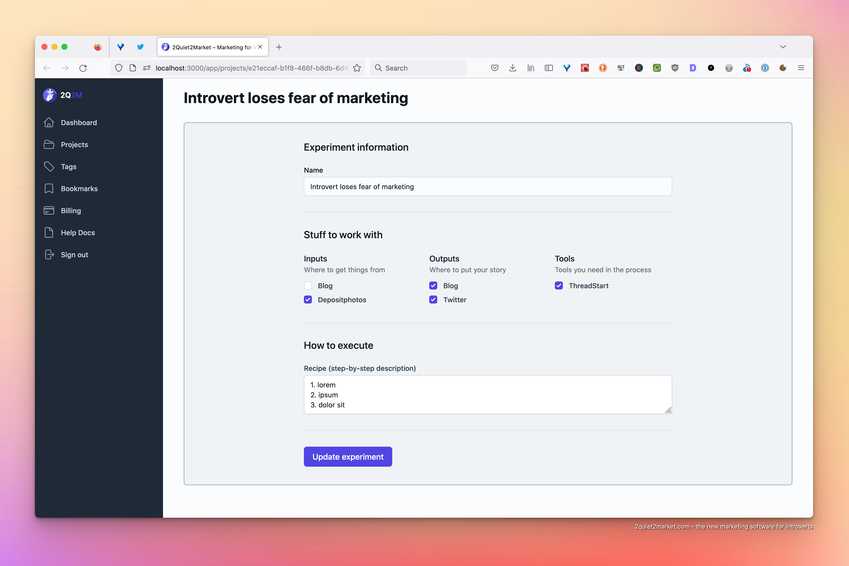How you can run marketing experiments as a solopreneur
...even when you consider marketing "uncool".
Published:

Hey all,
this week, I thought: Let's write an article about something concrete that solopreneurs can do to accelerate their business: Marketing experiments.
What is a marketing experiment?
A marketing experiment is a systematic procedure to test a new way to reach your audience and convince them to use what you have to offer.
You put something out there, have people consume it, and see what happens. Then you decide about the next steps.
It's basically a 6-step process:
- Make a hypothesis about what will happen when you market your stuff
- Choose a channel to reach your prospects (e.g. social network, blog, email)
- Tell a story (with text, images, audio, or video), via that channel
- Measure how people react to your story
- Learn by comparing reality to your hypothesis
- Keep what works, ditch what doesn't, then go to step 1.
Why it's difficult for solopreneurs to run marketing experiments
As a solopreneur, you wear many hats at the same time. You prefer building to marketing. But building or creating all day won't make people notice what you have to offer.
Some time ago, I acknowledged that it's true: I need marketing to sell the software that I build. From Jon Yongfook (maker of Bannerbear), I learned that there is a good rhythm for building and marketing:
- 1 week of coding
- 1 week of marketing
Jon even created a website that tells you whether it's coding week or marketing week. It simply looks like this:

I decided to adopt this rhythm, but I ran into a problem. Whenever I returned from building to marketing, I had forgotten one or more of these things:
- What story did I want to tell this time?
- Where is the material (text, images, etc.) for that story?
- Which channel do I want to use (my blog, my email list, my Twitter)?
Holy smokes, I had even forgotten how to write and publish a blog post or a newsletter, only because I was so deep into building my software! 😳
This will lead nowhere. We have to prepare and write everything down so that running an experiment becomes dead simple when marketing time comes around.
Preparation is key, you only need it rarely
You only need to prepare once. Then you can run a whole bunch of experiments. Then you prepare again, for the next batch. Preparation makes it much easier to run successful experiments.
This is how to prepare for your first experiment:
Nail your positioning
Ingredients:
- Product
- Features
- Benefits
- Qualities
- Stories
- Persona
Want to know how to nail these? I've written about that before. You can find it here.
Get totally clear on your messaging
Marketing is a kind of storytelling, to make the value of your product or service totally obvious for your prospects. Write down the main flow of every story you want to tell, so you can easily grasp it each time when you switch to marketing.
This has worked for me:
- Write a long, 500-word version of your story.
- Summarize it in 100 words.
- Make a one-liner about those 100 words.
- Create a multi-paragraph piece from the 500 words, adding a headline to each paragraph.
Now you have several versions of your story that you can use multiple times, across various channels, in long or short form. That's an asset, keep it to re-use it many times!
You can find more about messaging in marketing. Look here.
Collect your material and tools
Having a system for material and tools saves you time and energy.
Bookmark links to these things so you have them handy when marketing time comes:
- places where you store text, images, audio, or video
- material that you can use in your messaging
- tools to post your story, i.e. an email editor, a video recorder, or a social media scheduler
- channels = places on the Net where your audience hangs out, so you want to post there
These links rarely change, so bookmarking them once-and-for-all is time well spent.
Execution is easy, once you're prepared
With the preparation above, you're good to go. Define your experiments, run them, and learn from them. This is how you do it:
Define and run the experiment
Have a place where you write down a short description of your next experiment, so you won't forget what you wanted to test.

(Screenshot above: This new feature in 2Quiet2Market will support you with the design of your own marketing experiments. I will release it in January 2023.)
If you need to do it manually instead, then collect the following components that make up your experiment:
Hypothesis
Make a clear prediction like "If I tweet this thread, X people will see it, and Y people will sign up for my product".
Write in a form that makes it totally easy to judge whether the prediction is true or false, once the experiment will be over.
Your hypothesis may turn out to be wrong, but that's a success as well because you can learn from it.
Story
Tell a story about a transformation that your prospects are seeking. They want to get from pain to pleasure. They want to become a different person, the best version of themselves.
Help them by telling them these things:
- the approach to the transformation
- the required steps they need to take
- the success they can expect
- what they can do if it does not work at the first attempt.
Channel
Choose a channel through which you can reach your prospects with your story:
- Do they read your blog?
- Can you reach them by email, i.e. a newsletter or a free email course?
- Do they hang out on Twitter and other social networks?
During the preparation phase, you brainstormed a list of places where "they" hang out, and the means by which you can reach them. That's your channel list. To start your experiment, simply choose one of the channels from your list of bookmarks I mentioned above.
Recipe
The recipe you need to execute each time is almost the same:
- Read the story you prepared
- Transform it so it becomes applicable in today's situation
- Adapt it to the channel, so the channel can bring the story to your audience (e.g. turn it from long form content into a thread for Twitter)
- Publish it and be excited to see what happens!
Because this recipe is so generic, you can create a template for it in your favourite task management system. That way, you won't forget what it takes to run an experiment.
Measurement and Learning
After you told your story, measure the metrics you are interested in:
- number of people you reached
- amount of engagement you got from people (likes, comments, email replies, etc.)
- desired consequences you planned for (e.g. signups for your SaaS, sales of your book, etc.)
Compare this to what your hypothesis said: Did your dream come true? Or do you hear the crickets chirping through the market's silence? 😳
Execute one new experiment weekly, using the "story x channel = experiment" formula
You may find it hard to come up with a new experiment every week or so.
Here's a formula that will help you: story * channel = experiments.
This means, if you got 4 stories to tell and 3 channels to use, you can run 4 times 3 = 12 experiments!
With one experiment per week, that's 12 weeks of experiments: Ample time to discover new stories or new channels, so you'll never run out with things you have to give to your prospects.
From each experiment, you will learn:
- What story performed well?
- Which channel gave a loud echo, and which ones were just pure silence?
Get started with step 1 today!
If you follow the system that I outlined above, you become able to design and run your marketing sustainably, without losing your mind or your energy.
Start with the first step today: Nail your positioning.
If you need help with this, sign up and use 2Quiet2Market.com.
Comments welcome: